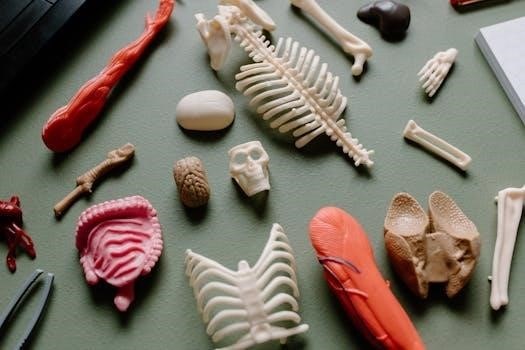Body systems graphic organizers visually represent the interconnectedness of major human systems. These tools aid in understanding complex relationships among organs, functions, and their roles in maintaining overall health.
Why Use Graphic Organizers?
Graphic organizers are effective educational tools for visualizing and understanding complex information, like the human body systems. They provide a structured framework for organizing facts, relationships, and processes. In the context of body systems, graphic organizers help learners connect different organs and their functions within each system. They also aid in understanding the interactions between various body systems, showcasing how they work together for survival.
Using graphic organizers enhances memory retention by presenting information visually and engaging different learning styles. Students can actively participate in completing the organizer, leading to deeper comprehension. These tools promote critical thinking as students analyze and synthesize information to fill in the graphic organizer. Furthermore, they help simplify complex topics, making them more accessible and manageable for learners of all levels. The structured format allows for easy review and recall of key concepts.
Overview of Human Body Systems
The human body functions through a network of interconnected systems, each with specific roles. These systems collaborate to maintain homeostasis, ensuring survival. Key systems include the circulatory, which transports blood, oxygen, and nutrients; the respiratory, responsible for gas exchange; and the digestive, which breaks down food for energy. The nervous system controls and coordinates bodily functions via electrical signals.
The skeletal system provides structure and support, while the muscular system enables movement. The excretory system eliminates waste products, and other systems like endocrine regulate hormones. Graphic organizers are helpful tools to understand the organs and functions of each system. They showcase how these systems interact with each other. Commonly examined systems include the circulatory, respiratory, muscular, digestive, and neurological systems. There are 11 body systems in the human body.

Major Body Systems Overview
The human body comprises several major systems working in harmony. These include circulatory, respiratory, digestive, nervous, skeletal, muscular, and excretory systems, each vital for maintaining life and overall bodily function.
Circulatory System
The circulatory system is vital for transporting oxygen, nutrients, hormones, and waste products throughout the body. Key components include the heart, blood vessels (arteries, veins, and capillaries), and blood itself. The heart functions as a pump, propelling blood through the vessels. Arteries carry oxygenated blood away from the heart, while veins return deoxygenated blood to the heart. Capillaries facilitate the exchange of oxygen, nutrients, and waste between blood and tissues.
Blood consists of red blood cells (oxygen transport), white blood cells (immune defense), platelets (blood clotting), and plasma (fluid component). This system interacts closely with the respiratory system, receiving oxygen and delivering carbon dioxide to the lungs. Proper circulatory function is essential for overall health and survival.
Respiratory System
The respiratory system is responsible for gas exchange, specifically taking in oxygen and expelling carbon dioxide. Key organs include the lungs, trachea, bronchi, and diaphragm. Air enters through the nose and mouth, travels down the trachea, and branches into the bronchi, which lead to the lungs. Within the lungs, tiny air sacs called alveoli facilitate the exchange of oxygen and carbon dioxide with the bloodstream.
The diaphragm, a muscle located below the lungs, contracts and relaxes to aid in breathing. Oxygen is essential for cellular respiration, providing energy for bodily functions. The respiratory system works closely with the circulatory system, which transports oxygen to cells and removes carbon dioxide waste. This interaction ensures proper oxygenation and waste removal throughout the body.
Digestive System
The digestive system processes food, breaking it down into nutrients the body can absorb for energy, growth, and repair. Major organs include the mouth, esophagus, stomach, small intestine, large intestine, liver, pancreas, and gallbladder. Digestion begins in the mouth with chewing and saliva, which contains enzymes to break down carbohydrates. Food then travels down the esophagus to the stomach, where it mixes with gastric juices to further break down proteins.
The small intestine absorbs most nutrients, while the large intestine absorbs water and forms waste. The liver produces bile, which aids in fat digestion, and the pancreas secretes enzymes to break down carbohydrates, proteins, and fats. The gallbladder stores bile. Undigested material is eliminated as feces. The digestive system ensures the body receives essential nutrients for proper functioning.
Nervous System
The nervous system is the body’s control center, responsible for coordinating actions and transmitting signals between different body parts. Its primary components include the brain, spinal cord, and a vast network of nerves. The brain, the central processing unit, regulates temperature, interprets sensory information, and controls movement. The spinal cord serves as the main communication pathway between the brain and the rest of the body.
Nerves transmit electrical and chemical signals, enabling rapid communication. The nervous system allows us to perceive our environment, react to stimuli, and maintain homeostasis. It interacts with all other body systems, influencing functions such as breathing, digestion, and circulation. This complex network ensures our bodies function in a coordinated and responsive manner, adapting to both internal and external changes. It is vital for survival and overall well-being.
Skeletal System
The skeletal system provides the structural framework for the human body, supporting and protecting vital organs. Composed of bones, cartilage, ligaments, and tendons, it enables movement and maintains posture. Bones, the primary components, offer rigidity and serve as attachment points for muscles. They also store minerals, such as calcium, essential for various bodily functions.
The skeletal system works closely with the muscular system to facilitate movement. Muscles attach to bones via tendons, allowing us to walk, run, and perform other physical activities. Additionally, the skeletal system protects internal organs; for example, the rib cage shields the heart and lungs, while the skull safeguards the brain. Bone marrow, found within bones, produces blood cells, contributing to the circulatory system’s function. This intricate system is crucial for overall health, movement, and protection.
Muscular System
The muscular system enables movement, maintains posture, and generates heat within the body. It comprises skeletal, smooth, and cardiac muscle tissues. Skeletal muscles, attached to bones via tendons, facilitate voluntary movements like walking and lifting. Smooth muscles, found in the walls of internal organs like the stomach and bladder, control involuntary movements such as digestion and urination.
Cardiac muscle, specific to the heart, contracts rhythmically to pump blood throughout the body. Muscles work in coordination with the skeletal system, allowing for a wide range of motions. They also play a crucial role in maintaining body temperature through shivering, a process that generates heat. Furthermore, muscles assist in maintaining posture and stability, preventing falls and injuries. Proper functioning of the muscular system is essential for mobility, internal organ function, and overall well-being.
Excretory (Urinary) System
The excretory system, primarily the urinary system, is responsible for filtering waste products from the blood and maintaining fluid balance within the body. Its main components include the kidneys, ureters, bladder, and urethra. The kidneys filter blood, removing waste such as urea and excess salts, and producing urine.
Urine then travels through the ureters to the bladder, where it is stored until it is eliminated from the body via the urethra. This system plays a critical role in regulating blood pressure, electrolyte balance, and red blood cell production. By removing waste and excess fluids, the excretory system prevents the buildup of toxins and maintains a stable internal environment necessary for overall health. Proper kidney function is essential for survival, and kidney failure can lead to serious health complications.

Key Components of a Body Systems Graphic Organizer
Effective body systems graphic organizers highlight key organs, their specific functions, and the vital interconnections between different systems. They provide a clear, visual framework for understanding complex biological processes.
Organs and Functions

A crucial element of a body systems graphic organizer involves clearly identifying each organ within a system and outlining its primary function. For instance, the heart circulates blood in the circulatory system, while the lungs facilitate gas exchange in the respiratory system.
Similarly, the stomach plays a vital role in the digestive system by breaking down food, and the brain controls bodily functions in the nervous system. Accurately mapping these relationships is essential for comprehension. The graphic organizer should show the major systems, with a word bank of organs. The key will show how organs work.
Including organs like the bladder, bones, and skin, along with their respective roles in the urinary, skeletal, and integumentary systems, provides a comprehensive overview. Detailing how hormones and other components contribute to regulate temperature, facilitate movement, and maintain overall homeostasis will help provide a complete picture.
Interconnections between Systems
Beyond individual organs and functions, a body systems graphic organizer must highlight the intricate interdependencies between different systems. The circulatory and respiratory systems work in tandem to deliver oxygen throughout the body and remove carbon dioxide. The digestive system provides nutrients that fuel the muscular and skeletal systems, enabling movement.
The nervous system coordinates and regulates the activities of all other systems, maintaining homeostasis. Understanding these interconnections reveals how disruptions in one system can impact others. The graphic organizer will show the key organs. It also shows the important connections.
For example, hormones produced by the endocrine system influence the function of multiple systems, including the reproductive and digestive systems. A visual representation of these connections enhances comprehension and emphasizes the holistic nature of the human body. These connections regulate the temperature. The skin, bones, lungs, heart, and bladder all play a role.

Where to Find Body Systems Graphic Organizers with Answer Keys
Several online resources offer body systems graphic organizers with answer keys. These platforms provide valuable tools for educators and students seeking to enhance their understanding of human anatomy and physiology.
Teachers Pay Teachers
Teachers Pay Teachers is a popular online marketplace where educators share and sell original educational resources. Here, you can find a wide variety of body systems graphic organizers, many of which come with accompanying answer keys. These resources often include detailed diagrams and fill-in-the-blank templates, catering to different learning styles.
The platform allows you to filter search results by grade level, subject area, and resource type. You can easily locate graphic organizers specifically designed for elementary, middle, or high school students. Many sellers offer both printable PDF versions and digital versions compatible with Google Slides.
Before purchasing, be sure to read product descriptions and reviews to ensure the resource aligns with your specific needs. Teachers Pay Teachers provides a valuable avenue for accessing high-quality, teacher-created materials to enhance learning.
Education.com
Education.com provides a wealth of educational resources for students of all ages, including a selection of body systems graphic organizers. This website focuses on providing structured learning materials to help students grasp key concepts. Graphic organizers are often included as part of larger learning modules or activities related to human biology and anatomy.
The resources available on Education.com frequently incorporate interactive elements and engaging visuals. While some resources may require a subscription, many free materials are available, including basic graphic organizer templates that can be adapted for various body systems. The platform allows users to search and filter resources based on grade level and subject matter, simplifying the process of finding suitable graphic organizers.
Keep an eye out for answer keys or accompanying worksheets that provide guidance on completing the graphic organizer. Education.com aims to provide comprehensive educational support.
Biology Corner
Biology Corner is a valuable online resource for biology teachers and students, offering a variety of free worksheets, labs, and activities. Among these resources, you can often find body systems graphic organizers designed to help students understand and organize information about the human body.
What sets Biology Corner apart is its focus on providing practical and accessible materials that can be easily integrated into classroom lessons. The site often includes answer keys for its worksheets and graphic organizers, making it easier for teachers to assess student understanding. Biology Corner’s graphic organizers typically cover the major body systems, such as the circulatory, respiratory, digestive, and nervous systems.
These organizers help students identify the main organs, functions, and interconnections within each system. You can usually find a downloadable PDF version of the graphic organizer, along with a corresponding answer key for easy use.
